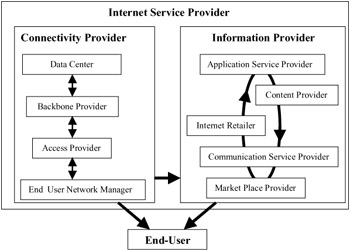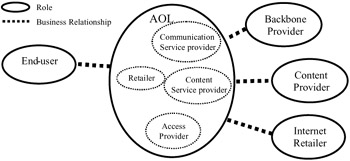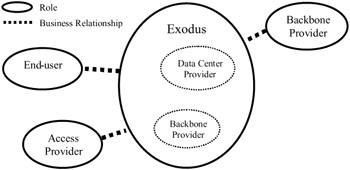The ISP Reference Model
In this section we introduce the ISP reference model that enables a more systematic analysis of the revenue-sharing schemes in the Internet market and allows examining the impact of new pricing schemes and charging technologies. We also map two ISP cases (AOL-Time Warner and Exodus) to acquire insight on the bilateral revenue-sharing mechanisms.
The proposed reference model is introduced to classify ISPs according to type of services offered. An ISP is defined as a business entity that may offer any type of service on the Internet. Considering the nature of such services, we identify two broad categories of ISPs: Connectivity Service Providers and Information Service Providers. To identify and examine the revenue flows, we introduce a more detailed classification of the ISPs based on their business activities.
Connectivity Service Providers mainly offer infrastructure services for data transmission and can be classified according to their functionality on the Internet. Four types of connectivity providers are identified:
-
End User Network Manager: This player might be the individual end user or the IT department of a company that manages the network edge (e.g., single PC or LAN).
-
Access Service Provider: This player covers the "last 10 miles" between the end user's network and the backbone, utilizing copper lines, fiber lines, wireless and mobile networks. Access providers mainly use local telecommunications operator networks (e.g., British Telecom, SBC) that provide telephone lines for dial-up access to the Internet. Mobile operators (e.g., Vodafone and DoCoMo) or wireless access service providers may also provide Internet access. This player is an IP network service "retailer."
-
Backbone Provider: This player manages a core IP backbone network, which has wide (sometimes global) coverage. The backbone providers develop, maintain, and upgrade the global network infrastructure (e.g., AT&T, Qwest, and Level3). The backbone provider is a network service "wholesaler" and connects access service providers to the Internet. Initially, backbone providers offered global access and interconnection services only to national or local ISPs through their high-capacity networks, but later they entered into the retail business by providing network services to business customers. In order to offer global coverage, they establish peering agreements with each other.
-
Internet Data Center Provider: This player provides a secure facility to the information provider, guaranteeing high reliability and availability of its servers and high-speed connectivity to backbone providers (e.g., Exodus and Akamai).
Information Service Providers are classified according to the type of information services offered. Five types of information service providers are identified.
-
Application Service Provider: This player develops software applications and charges customers for their usage. The application service provider is responsible for the maintenance and management of the application. Web hosting is a typical application offered by this player.
-
Content Provider: This player collects, organizes, and presents information (e.g., Yahoo, Marketwatch, and CNN) in text, audio, or visual form. The content provider also offers personalized information services.
-
Internet Retailer: This player sells any type of product on the Internet by using e-commerce applications (e.g., Amazon.com, Bamm.com, Barnesandnoble.com).
-
Communication Service Provider: This player offers communication services like Internet telephony, e-mail, or fax (e.g., Net2Phone, AOL, and efax.com). The communication service provider uses network infrastructure to provide value-added communication services that may compete with services of incumbent telecommunication operators.
-
Marketplace Provider: This player either negotiates network services for ISPs that want to lease network services, or provides an environment for ISPs to sell and buy network services (e.g., BandX). In addition, this player may provide, maintain, and manage a market environment for transactions of information services (e.g., eBay).
Finally, another key player in the Internet market is the end user that consumes Internet services. End users are classified into business customers and individuals. Business customers include any business entity that uses Internet services for generating revenue inside or outside the Internet. An individual customer has lower propensity to spent money for Internet services than business customers. This difference is critical when considering ISP pricing strategies and, consequently, has an effect on the total revenue of the ISP.
Business relationships between connectivity service providers, information service providers, and end users are presented in Figure 1, where arrows represent the direction of the service delivery: ISPx → ISPy means ISPx delivers service to ISPy. A connectivity service provider might provide services to information service providers, end users, and to other connectivity service providers. An information service provider offers services to end users and other information service providers. The end user only consumes services.

Figure 1: Model of ISP's Business Relationships
The interactions among the connectivity service providers are determined by their functionality on the Internet. The end user network is always connected to the network of the access service provider, whereas the access service provider has at least one connection to the backbone. The Internet data centers are located within the backbone. Figure 1 depicts these relationships by black arrows. The information providers are more flexible with respect to the business relationships among each other. Any type of relationship is possible (represented by the circle in Figure 1).
The business relationships between ISPs comprise the exchange of usage charging information, service provisioning information, and traffic data. This exchange of information is necessary for pricing. For example, the exchange of connection usage data between an access service provider and other ISPs might be necessary to collect accounting information. The exchange of modem pool blocking data is important to relate to overall service quality objectives. Metered IP traffic could be exchanged to decide on possible terms of interconnection agreements between backbone providers.
In the next subsections we map two ISPs (AOL-Time Warner and Exodus) into the reference model. AOL-Time Warner is considered an information service provider, and Exodus—which is a Cable & Wireless subsidiary—is considered a connectivity service provider.
AOL-Time Warner
AOL-Time Warner has a leading position in the information services and dial-up access services market segments. Its customer base mainly includes individual end users. AOL's revenue mix consists of subscription, advertising, e-commerce services, and Internet application sales (TheList, 2002).
According to the reference model, AOL-Time Warner is an information provider that incorporates the business activities of an access service provider, an Internet retailer, a communication service provider, and a content provider. AOL-Time Warner provides Internet access to individuals and business customers. These services are bought from third parties and then resold in bundles with content or other personalized services. The information services include content, retailing of products, messaging, and Internet telephony, which are owned by AOL-Time Warner or are bought from third parties.
AOL-Time Warner's business relationships model comprises the relations with backbone providers, Internet retailers, content providers, and end users (Figure 2). Based on the services delivered, the value flows between AOL-Time Warner and the other ISPs and end users can be characterized as follows:
-
Backbone Service Provider-AOL-Time Warner: This business relationship concerns the provision of network services. AOL-Time Warner does not own backbone network infrastructure, but buys network service, through transit agreements, from backbone providers (e.g., Sprint, GTE, and MCI-WorldCom).
-
Content Provider-AOL-Time Warner: This business relationship involves provision of information and marketing services. AOL-Time Warner incorporates the role of content provider through its interactive service online business. Content provision is one of its main revenue streams. AOL-Time Warner exploits its large customer base by selling its own content or reselling content of other ISPs.
-
Internet Retailer-AOL-Time Warner: This business relationship concerns AOL-Time Warner's intermediation between a retailer and a customer, as a sales point for products and services. The retailer usually pays AOL-Time Warner a commission on the total sales revenue. AOL-Time Warner also incorporates the role of Internet retailer through its Netscape Enterprise Solution business, which is running e-commerce activities in the retail sector.
-
End User-AOL-Time Warner: This business relationship concerns AOL-Time Warner's provision of bundled (access and content) services to the end user. Subscription is based on various pricing schemes that mainly involve a flat-rate membership fee for a specific time period. AOL-Time Warner has established a brand name in the Internet access service provision that leads to high market share.

Figure 2: AOL's Business Relationships Model
Exodus
Exodus owns a worldwide backbone network that interconnects to the Internet backbone and its Internet data centers. Exodus aims at establishing a defensive competitive advantage in the market by maintaining a state-of-the-art network of data centers supported by its robust backbone architecture. Exodus' revenue mix consists of server hosting services, Internet connectivity services, and network management services (TheList, 2002).
According to the ISP's reference model, Exodus is a connectivity service provider that incorporates business activities of a backbone provider and a data center provider. Exodus' business relationships model comprises relations with backbone providers, access providers, and end users (Figure 3). Based on the services delivered, the value flows between Exodus and the ISPs, and the end users are:
-
Backbone Provider-Exodus: This business relationship concerns the provision of network services. As both players incorporate the backbone provider role, the exchange of services between them involves interconnection and transport services. Exodus has both peering and transit agreements. Exodus has established 154 public and 48 private peering arrangements, resulting in strong connectivity to the Internet.
-
Access Provider-Exodus: This business relationship concerns Exodus' provision of wholesale services, universal access, and connectivity. In this case, access providers pay Exodus according to the type of interconnection agreement that they have. Exodus pricing schemes for network services are both flat rate and usage based.
-
End User-Exodus: This business relationship concerns Exodus' Internet connectivity and application services provision for business customers. Exodus hosts a significant portion of high-performance websites on its Internet data center and provides services mainly to business customers (e.g., Yahoo!, eBay, Gateway, Nordstrom, Virgin Group).

Figure 3: Exodus' Business Relationship Model
EAN: 2147483647
Pages: 198